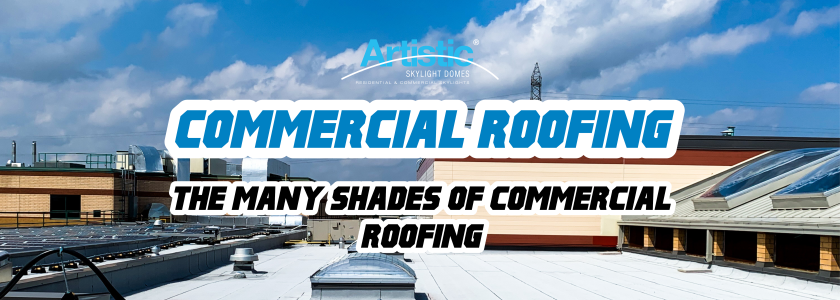
There are more than a few ways to top a commercial facility. A bird’s eye view of any district will reveal a range of commercial roofing styles, each of which offers varying advantages in terms of safety, performance, and sustainability.
“As skylight suppliers and installers, our people have to be ready to work on a wide range of surfaces and materials, and that means being experts on all types of commercial roofing systems,” says Marco Ferrazzo, Process Manager with Artistic Skylight.
Ultimately, he adds, the goal of every roof is to protect facility occupants and assets. And depending on the building’s size and configuration, there are several approaches to consider:
Built-up roofing systems (BUR)
This is the classic “tar and gravel” approach to roofing that has been employed for generations and remains popular due to its durability and cost-effectiveness. Ideal for flat or low-slope roofs, this system uses layers of asphalt (aka bitumen) and reinforcing fabric, and is capped with a top layer of aggregate (e.g., stone or gravel).
Modified bitumen
Similar to BUR systems, this method uses a material comprised of asphalt and a chemical polymer that can be applied as self-adhesive sheets, cold or torch-applied adhesives, or hot-mopped asphalt. This “modified” asphalt material is designed to protect roofs from severe environments and extreme weather.
Single-ply roofing
These are roofs installed in a single layer, either using thermoset roof membranes, such as EPDM (ethylene propylene diene terpolymer), or thermoplastic roof membranes, such as TPO (thermoplastic polyolefin), PVC (Polyvinyl Chloride), or EPDM (ethylene propylene diene terpolymer).
Each single-ply roofing material has its own characteristics in terms of durability, weight, reflectivity, and resistance to damage. Generally, EPDM, PVC, and TPO membranes are all made to withstand the elements and hold up against peeling, cracking, and other wear and tear.
Metal roofing
A stylish and durable alternative to traditional roofs, metal roofing systems can be made with a wide variety of materials, including corrugated galvanized steel, copper, aluminum, stainless steel, tin, stone-coated steel, metal tile sheets, and aggregates of zinc, aluminum, and silicon-coated steel. These roofs can be used for low and steep slope roofs.
Liquid-applied roofing
Much like the name suggests, these are systems that use a coating material made up of several liquid components which are then applied with mesh membranes. The result is a self-adhering material that can be smoothed out for a continuous, even surface.
Green roofs
Also known also as “living roofs,” these are roofing systems that incorporate layers of growing mediums and vegetation over a waterproof membrane. Their purpose is to create a living, “breathing” environment that can be used to grow food, create unique rooftop green spaces, and provide a biodiverse space for birds and pollinators. Green roofs have grown in popularity over the years thanks to their ability to absorb heat and rainwater, provide a protective roofing layer, and contribute to a greener and more sustainable built environments.
Photovoltaic (PV) solar panels
The practice of installing rooftop photovoltaic materials/panels that convert natural light into energy that can be fed back into the building. As energy storage technologies evolve, expect to see more commercial facilities harnessing this eco-forward roofing alternative.
There is no shortage of strategies when it comes to commercial roofing. Choosing the right approach comes down to recognizing your options and what will work best for your environment, footprint, and budget.
“A lot of science and design expertise goes into commercial roofing systems,” adds Ferrazzo. “Our job is to know what we’re working with so that we can install skylights that enhance their role.”



